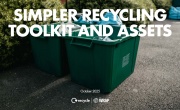How the textiles industry can achieve zero-waste
Responsible for 10 per cent of global carbon emissions – more than international flights and maritime shipping combined – and worse for the environment than plastic, textiles is a highly problematic waste stream but one that has largely flown under the radar. Moves are finally being made to make the textile industry circular, but what will be involved? And what will it take?
 Responsible for 10 per cent of global carbon emissions, the textile industry is more environmentally damaging than plastic, or international flights and maritime shipping combined.
Responsible for 10 per cent of global carbon emissions, the textile industry is more environmentally damaging than plastic, or international flights and maritime shipping combined.
The pieces of clothing and fabrics that we see in our shops embody huge volumes of energy and water. Not to mention the harmful chemical by-products from the manufacturing process that make their way into waterways and soils. Or the pervasive microfibres that are released from our laundry; responsible for 70 per cent of Arctic ocean plastic microfibre pollution. With the growth of fast fashion forecast to continue in coming years, it’s imperative that the industry finds new ways to lessen its impact. Moves are finally being made to make the textile industry circular, but what will be involved? And what will it take?
Textile waste
Currently, huge swathes of textiles’ embodied energy are lost. 62 per cent of used clothing and textiles in Europe end up either being incinerated or sent to landfill. Globally, 92 million tonnes of textile waste end up in landfills every year.
So far, textiles as a waste stream have largely flown under the radar. Consumers are generally unaware of the environmental impact of the clothes that they buy, and textile waste reporting, legislation and recycling technologies are relatively backward in comparison to totem wastes like plastic. The industry is seeing a scramble to legislate and control the industry, with the European Recycling Industries' Confederation (EuRIC) recently pushing for regulation around the recording of export data.
There is, however, hope. Zero Waste Europe (ZWE) released a report in January this year which examined the opportunity for circularity within the fashion industry – an industry the report view as being based on ‘overconsumption, resource depletion, social exploitation, fossil-based fibres, and greenwashing’.
In the report, titled ‘Beyond Circular Fashion – a new business model for the fashion industry’, ZWE recommends several steps to move towards circularity, including designing for physical and emotional durability; demand-driven production to phase out unsold items and the discounts that encourage overconsumption; full supply chain transparency and traceability post-sale; and extending the life of garments beyond first ownership.
Theresa Morsen, Waste Policy Officer at ZWE, said: “With this report we are establishing guidance for businesses to become truly sustainable, ending overproduction and consumption to respect planetary boundaries. This will help scale up sustainable business models and ZWE intends to empower pioneers in this field.”
Reclaiming fabrics
Several of ZWE’s recommendations focus on directly reducing the textile waste stream through reuse and recycling. According to EuRIC, reused textiles result in 40-70 times less impact on the environment than the production of new material, using only 0.01 per cent of the water.
Reused clothing refers to items that can be continued to be used without significant alteration to their form or purpose. Charity shops, clothing donation points, vintage stores or online secondhand marketplaces are all examples of how textiles can find their way to be reused, and in a world centred around reusable clothing, durability is key.
Once they are outworn and torn, the next best option is for the material to be recycled into new textiles. However, WRAP found that only around one per cent of used clothing is recycled in the UK. The rest is either exported, incinerated or sent to landfill. This is due to a significant lack of infrastructure for textile recycling in the UK, with only a handful of specialised recycling facilities for textiles.
Charity shops are embracing the role that they play in developing a circular economy for textiles. Last year, SATCoL – the Salvation Army’s charity arm – launched an automated recycling sorting system – Fibresort – to sort materials no longer fit for reuse.
Bernie Thomas, Circular Economy and Sustainability Manager at SATCoL, told Resource: “We are helping develop a closed-loop recycling system for textiles and are collaborating with various partners in the value chain to help make this happen.”
Whilst they have been heartened by the level of interest from across the industry, they noted that most of the donations they receive are actually suitable for reuse. The organisation says it is looking at ways we can encourage consumers to also donate outworn and torn items for recycling, rather than discarding these in residual waste.
Fibre-to-fibre recycling
As highlighted in EuRIC’s textiles life-cycle assessment, innovation in fibre-to-fibre recycling will be a major part of developing circularity for the industry. However, recycling textiles is difficult. They often contain a mix of different fibres, materials and dyes, making it challenging to separate and process them efficiently.
Thomas explains: “Some fibres are more challenging to recycle than others. Polyester-rich blends of fibre are a particular challenge and they make up a large proportion of the textile waste stream, although there are a number of recycling companies innovating in this area so we can expect to see some good progress over the coming years.”
Indeed, the UK Government is increasing funding for innovation in the sector. Most significantly, UK Research and Innovation (UKRI), recently ran a funding competition to invest up to £4 million in an innovation project to develop and demonstrate closed-loop sorting and recycling for the fashion and textile sector at scale. This will be followed by a further £11 million in funding to further develop specific sorting and recycling projects and infrastructure.
Innovation is also being seen in the design of fabric for reuse. Meryl Fabric’s new material is designed to be recycled once it can no longer be reused. The polyamides used can be repeatedly recycled: “We are reinventing textile use, pioneering sustainable fabric items offering ‘infinite recyclability’,” said Ingo Mangold, Head of Design and Engineering at Meryl Fabrics.
“We have worked to eliminate the problem of [microplastics]; our innovative technology uses a hydrogen bonding system to create strong molecular chains that seal all microplastics into the filaments, eradicating the release of microfibres into the air, rivers or oceans during wear or washing.”
Textile legislation
In the UK, there is no legislation to steer the textiles industry towards reuse and recycling. As Thomas explains: “There are currently no mandatory requirements around the sustainability of clothing design and production. Many brands are already taking action as their customers are demanding it. However, legislation can play a role in driving change more quickly and creating a level playing field across the market.”
In EU member states, it is expected that extended producer responsibility (EPR) for textiles will be introduced as one of the targeted revisions of the EU Waste Framework Directive (WFD), currently scheduled to be implemented this year.
Thomas added: “[We see] an extended producer responsibility (EPR) scheme for textiles as an important piece of the puzzle. EPR would encourage products to be eco-designed and stimulate the market for recycled content in textiles, as well as help develop recycling innovation and infrastructure.” Thérèse Coffey (Defra Secretary of State) has, however, said that the UK Government has no plans to do likewise.
Mangold echoes SATCoL’s desire for legislation: “The world of textiles has been doing what they have done for a long time; this has driven the market into a constant price war and made it quite challenging to infiltrate existing processes and buying relationships. Regulatory frameworks that promote innovative solutions will move circular technologies into the market.”
Whilst we currently have little regulation to prompt change, Textiles 2030 is a voluntary government initiative to encourage a more sustainable textile industry. Its signatories such as M&S, Urban Outfitters and ASOS have made progress in reducing the carbon and water footprint per item of clothing, but the overall footprint of the sector is still increasing on account of the increasing volumes being produced.
Holistic thinking
According to a report by the Ellen MacArthur Foundation, if the UK's clothing industry were to become more circular and sustainable, it could reduce its carbon emissions by 24 million tonnes of CO2e per year by 2050. This would be equivalent to taking 8.7 million cars off the road.
The industry will need to change significantly to reach this point. The government needs to focus on bringing mandatory legislation into play which is based on the prioritisation of reuse, increasing local recycling capacity for textiles, and stimulating innovation. The issues in the textile industry require holistic thinking at all stages of the supply chain.
Thomas added: “Everyone has a role to play in making this vision a reality: as a society, we need to think more carefully about the type and amount of clothes we are consuming. Retailers, brands and manufacturers need to make sure they ecodesign and manufacture textiles with sustainability in mind and develop business models that enable people to buy and consume differently and less frequently.”
The UK food and drink industry recently announced an unprecedented collaboration with WRAP and WWF UK to measure and report greenhouse gas emissions. It is hoped that the partnership will show the scope of progress that can be made if stakeholders come together to solve industry-wide issues. The textile industry would greatly benefit from the same approach to make a truly circular textile industry possible. 









